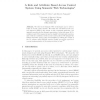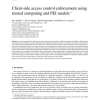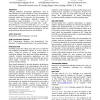626 search results - page 53 / 126 » Power Control for User Cooperation |
OTM
2007
Springer
14 years 4 months ago
2007
Springer
We show how Semantic Web technologies can be used to build an access control system. We follow the role-based access control approach (RBAC) and extend it with contextual attribute...
JHSN
2006
13 years 10 months ago
2006
It has been recognized for some time that software alone does not provide an adequate foundation for building a high-assurance trusted platform. The emergence of industry-standard ...
DASFAA
2010
IEEE
13 years 10 months ago
2010
IEEE
Achieving data security over cooperating web services is becoming a reality, but existing XML access control architectures do not consider this federated service computing. In this...
CHI
2005
ACM
14 years 10 months ago
2005
ACM
Although slideshow presentation applications, such as PowerPointTM have been popular for years, the techniques commercially available to control them rely on mouse and keyboard, w...
ACSAC
2009
IEEE
13 years 7 months ago
2009
IEEE
Abstract--Role based access control (RBAC) is a powerful security administration concept that can simplify permission assignment management. Migration to and maintenance of RBAC re...



